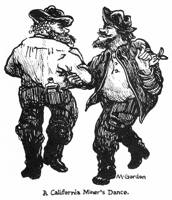
|
The Society of Folk Dance Historians (SFDH)
Dance in the Old West
[
Home |
About |
Encyclopedia | CLICK AN IMAGE TO ENLARGE |

|
Dance historians and ethnologists are familiar with the importance and universal practice of dance in folk cultures in Europe, Latin America, Polynesia and elsewhere, but we may not realize the importance of dance in our own Old West.
The folk culture of the Old West closely paralleled those in Europe, though very different in many important ways. In the folk life of pre-Industrial Europe, dance served as a vehicle for social interaction, courtship, and even social control. In tribal societies (such as the Native American) dance was, and is, a form of communication with unseen spirits, a form of prayer, and a psychological preparation for war or the hunt.
In America's Old West, dance became a social activity of utmost interest and importance. Though American and European folk dance were both developed in an impoverished life of hard, unending toil, with wealth concentrated in the hands of an elite few, America was unique. One was not bound by social strata – a new and unique concept in history, which allowed an unrestrained mixing of all levels of society and the possibility of aspiring to higher economic and social status.
 Dance was for socializing and release from unending drudgery, a convenient form of recreation, and social interaction not available by other, more expensive, and less accessible means. It was fun, it was free (or cheap), it brought opposite genders together in an acceptable venue (remember, this is in the middle of the Victorian era), and it provided both physical and artistic expression. So, dance they did, lowly cowboys rubbing elbows with cattle barons, lawmen and horse thieves, proper ladies, and soiled doves alike.
Dance was for socializing and release from unending drudgery, a convenient form of recreation, and social interaction not available by other, more expensive, and less accessible means. It was fun, it was free (or cheap), it brought opposite genders together in an acceptable venue (remember, this is in the middle of the Victorian era), and it provided both physical and artistic expression. So, dance they did, lowly cowboys rubbing elbows with cattle barons, lawmen and horse thieves, proper ladies, and soiled doves alike.
Immigrants came in a flood from the eastern coastal regions of New England, the Old South and Europe, fleeing from rocky New England farms, the destroyed Old South, feudal poverty, crowded cities, memories of slavery, a criminal past; everyone had their own reasons, admirable or otherwise. It became a fashionable and common practice to yield to the desire to travel that lies in all of us and it became infused into the American spirit.
Eastern and European accents and traditions were everywhere on the frontier and the Old West must have been a colorful mixture indeed with cattlemen, sheep men, miners, loggers, gamblers, outlaws, lawmen, adventurers, merchants, teamsters, bankers, gunmen, lawyers, artists, clerks, scions, prostitutes, preachers, migrant laborers – all the ingredients for the creation of a rugged, new society. It was a population of strong-willed, independent individuals driven by powerful forces common to adventurous souls.
In a normal folkloric process, the new Westerners adapted the traditions and customs they brought with them to suit their new situation and tastes, altering old ones or replacing them with new ones to create a new, unique Western folk culture with dance at its center. That dance was a far cry from today's Country Western dance.
The European Waltz, Polka, Schottische, and Mazurka were widely known and practiced almost unchanged from their European versions. To be sure, new steps and styles were created to better interpret the music played by local fiddlers or to accommodate rough floors and heavy boots. The endlessly turning European Waltz was slowed and given new figures. Among the most charming variations of the European couple dances are those developed in northern Mexico by settlers whose descendants still live in the south Texas and northern Mexico border region.
The influence of West Point was prominent. Dance was considered an important requirement to becoming an officer and a gentleman and the military balls on the frontier were led by men and ladies who were skilled in dance. Many enlisted men were directly from Europe, especially Ireland, where the Waltz was part of the common dance repertoire. Military balls were major events at the various forts across the West, well attended and fashionably attired.
It must be mentioned that dance etiquette required men to remove swords, side arms, and spurs to dance. It was considered very rude to risk catching a lady's skirts in a cowboy's spur rowels. Hats, however, were traditionally worn while dancing.
Because newcomers were unfamiliar with the sequences and finer points of the New England Lancers, Contras and Quadrilles, the memorized, dance master-created figures gave way to called figures. The Clog< of the Appalachian Mountains' Irish and English settlers was impossible in Western and cavalry riding boots and was discarded in favor of a smooth gliding step. Big Circle Dance figures from the Appalachians, called by a leader, blended nicely into the Quadrilles and our national Square Dance was born.
Dances were held on every occasion, whether it be a barn raising, Saturday night, a wedding, the end of a trail drive, or the arrival of a new wagon train in town. Even then, dances were held only rarely and under sometimes trying circumstances. Impromptu dances were often held outside on a large wagon sheet spread over the burrs and prairie dog holes, often in a blazing Texas sun.
A rough-hewn log floor (called a "puncheon floor") sometimes served as a dance floor, necessitating a change from the smooth, gliding steps possible on a smooth floor; hence, some of the high lifting movements still found today in some of the Western dance styles. Ladies detested the puncheons because they quickly wore out their dancing shoes.
When women were scarce (as frequently was the case in the early days), it was common practice for several rough-hewn men to "heifer brand" themselves by tying a scarf around an arm or donning an apron – sometimes even a dress and bonnet – and unabashedly assuming the role of the fairer sex in a Waltz or Polka with another equally grubby gent. For Americans and Europeans raised on Puritan and Victorian rules of conduct, this indicates how far they were willing to go for a dance.
As early as 1870, a social season was well established in the larger towns in Texas. The program for the Opening Ball of the 1871 season in Austin shows a fine mixture of couple dances, sets, squares, and round dances:
SET 1
Grand March: Willowdale
Quadrille
Waltz: Nobody's Darling
Polka: Tremolo
Lancers
Redowa
Varsouvienne
Quadrille
Kiss Waltz
Schottische: Silver Cloud
SET 2
Camille
Lancers
Polka Redowa
Galop: Carlotta
Quadrille
Waltz: Ristori
Fling Schottische
Mazurka: Twilight Thoughts
Folks took their dances seriously. One story recounts the effort made by one young cowboy to take his best girl to a dance. She lived 12 miles from the ranch where he worked; he rode 24 miles to ask her to the dance and return home. It was 16 miles from the ranch to town; he rode there and back, another 32 miles, to rent a buggy and return to the ranch. Then he drove the buggy 12 miles to her home, 8 miles to the dance, 8 miles back to her home and 12 more miles to the ranch. Finally, he rode the 16 miles to return the buggy and 16 more miles to return home – 128 miles of riding to take his best girl to a dance.
That kind of dedication wasn't unusual. Near Amarillo, two cowboys spent a total of six days going to and returning from a dance with their partners; the dance lasted seven hours.
More than a decade before the Old West began (generally considered to be 1865, following the Civil War), the hardy 49ers of the California Gold Rush took their dancing seriously, too. Gold-crazed miners, hardened by the unbelievably harsh life in the mines, took eagerly to the Mexican Californios' passion for dance, adding their own contributions to the Spaniard's graceful fandango, the word becoming synonymous with dance and applied to every occasion in which dance was a part. Though the Spanish danced their elegant native dances and Waltzes, it is noted that the Polka was the major dance of the camps, recorded here in the early 1850's – less than ten years after it was first recorded in Bohemia in 1844! The arrival of a woman in the mines was cause for a ball and the mines were deserted for the evening on a remote chance to see and maybe even speak to or dance with the rare fair sex. Every man considered every woman to be beautiful and no woman remained unmarried long after arriving in camp. There must be some very interesting stories, long untold, of mining camp romances.
The square dance seems to satisfy the American character better than any other dance by combining the various parts from which it was created into a complex, smoothly functioning, cooperative dance, all working together like a well-timed piece of machinery. That co-operative attitude is a gift from our German, English, Irish, and Czech pioneers, to whom precision and quality of workmanship were paramount, and it ensured the teamwork necessary for successful occupation of the West and development of the American culture.
It is interesting to note that in the early years of this century, the Square Dance nearly became extinct as attention turned to the new Ragtime or Jazz music and the more fashionable "new" dances of the Roaring '20s. It remained for Lloyd "Pappy" Shaw, a school administrator of Colorado Springs, Colorado, to realize the endangered state of the dance and almost single-handedly revive it, incorporating it into his school curriculum. By interviewing old-timers he was able to reconstruct the figures and determine the music used in the Old West. The rest is history, as the Square Dance movement grew from his efforts – it has been officially declared our national dance.
Modern culture has long since smothered and replaced the Old West culture, in fact if not in spirit. Sociologists tell us it still strongly effects America's cultural personality and how we are perceived by the rest of the world. Indeed, it can be argued that the thirty-five years of the Old West's glory days still effects us all in more ways than we know.
BIBLIOGRAPHY
- Casey, Betty; Dance across Texas, University of Texas Press; Austin, TX; 1985.
- Shaw, Lloyd; Cowboy Dances; Caxton Printers, Caldwell, ID; 1948.
- Schneider, Gretchen; Pigeon Wings and Polkas: The Dance of the California Miners; Dance Perspectives Foundation; New York, NY, Winter Quarter, 1969.
DOCUMENTS
- Boys' Night Out in Leadville, an article.
- Country Western Tips and Suggestions, an article.
- Gold Miners Dances
- Richard Duree, an article.
Used with permission of the author.
This page © 2018 by Ron Houston.
Please do not copy any part of this page without including this copyright notice.
Please do not copy small portions out of context.
Please do not copy large portions without permission from Ron Houston.